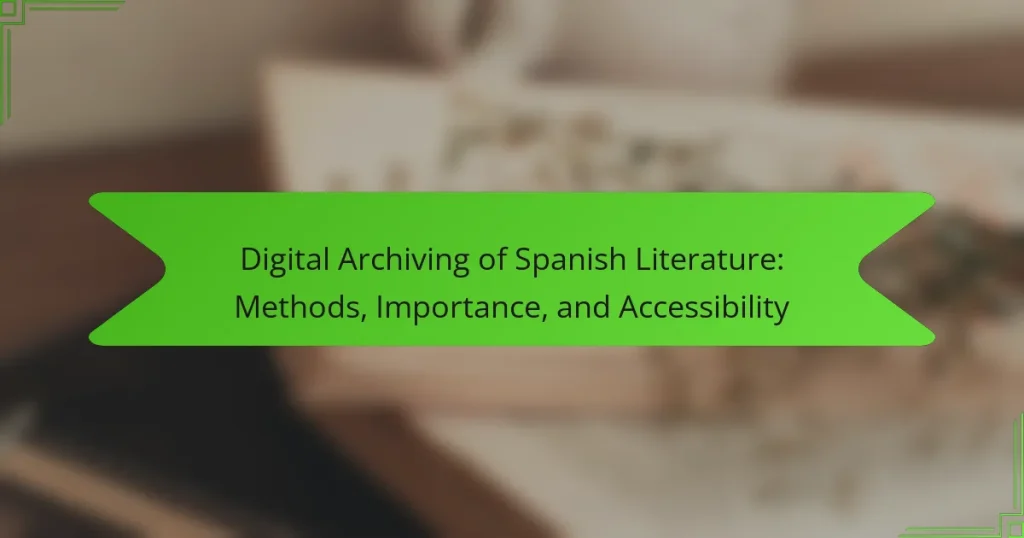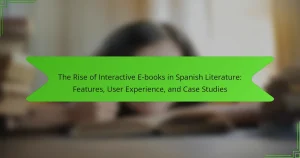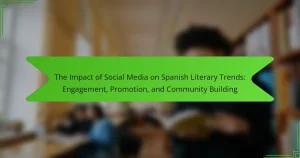Digital archiving of Spanish literature preserves cultural heritage and enhances accessibility for scholars and readers. This article explores methods like digitization and metadata creation, addresses challenges such as funding and technological limitations, and highlights the importance of collaborative platforms in promoting literary works. Additionally, it examines unique attributes that enrich the reader’s experience and ensure long-term sustainability.
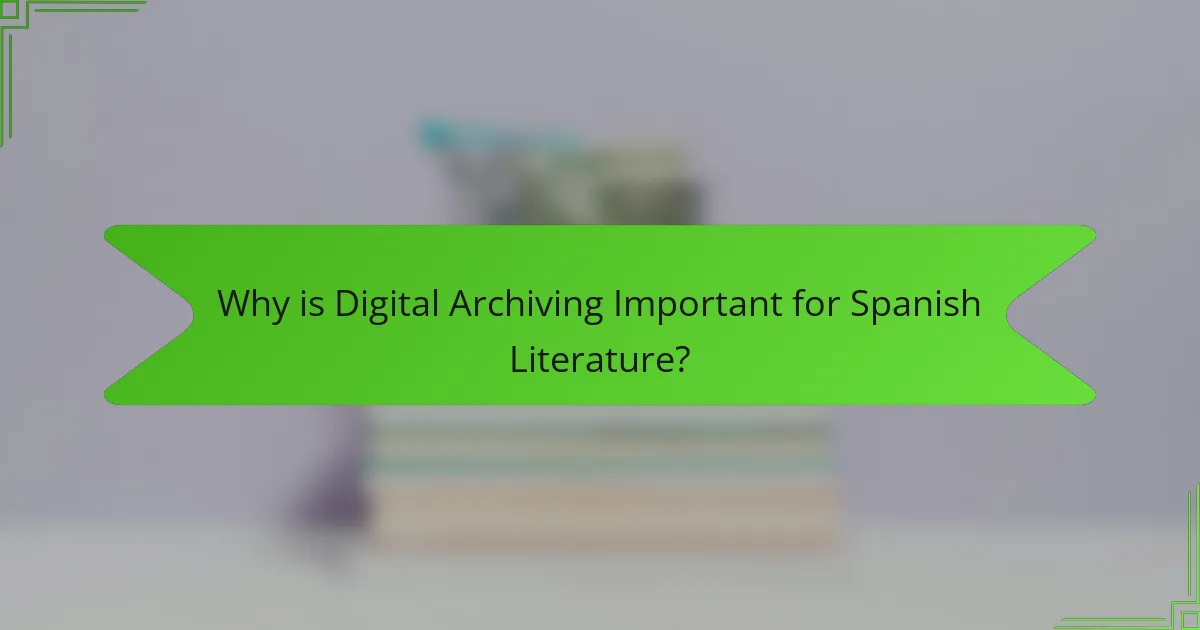
Why is Digital Archiving Important for Spanish Literature?
Digital archiving is crucial for Spanish literature as it preserves cultural heritage and enhances accessibility. By digitizing texts, scholars and readers can access works that may be rare or deteriorating. This method enables broader dissemination, ensuring that diverse voices in Spanish literature reach global audiences. Additionally, digital archiving facilitates research by providing searchable databases, allowing for deeper analysis and understanding of literary trends and movements.
What are the Benefits of Digital Archiving for Literary Preservation?
Digital archiving significantly enhances literary preservation by ensuring accessibility, protecting against loss, and facilitating research. It allows for the long-term storage of Spanish literature, making it available to a global audience. This method preserves unique attributes of texts, such as original formatting and annotations, which might be lost in traditional archiving. Moreover, digital archiving promotes collaboration among scholars, enabling the sharing of resources and findings, thereby enriching the study of Spanish literature.
How Does Digital Archiving Enhance Accessibility to Spanish Literature?
Digital archiving significantly enhances accessibility to Spanish literature by digitizing texts and making them available online. This process allows wider audiences to access rare works, fostering greater appreciation and study of Spanish literary heritage. Digital archives often include various formats, such as e-books and multimedia resources, making literature more engaging. Furthermore, the preservation of texts in digital form ensures their longevity, protecting them from physical degradation. As a result, scholars and enthusiasts can explore a diverse range of works from anywhere in the world, breaking geographical and economic barriers.
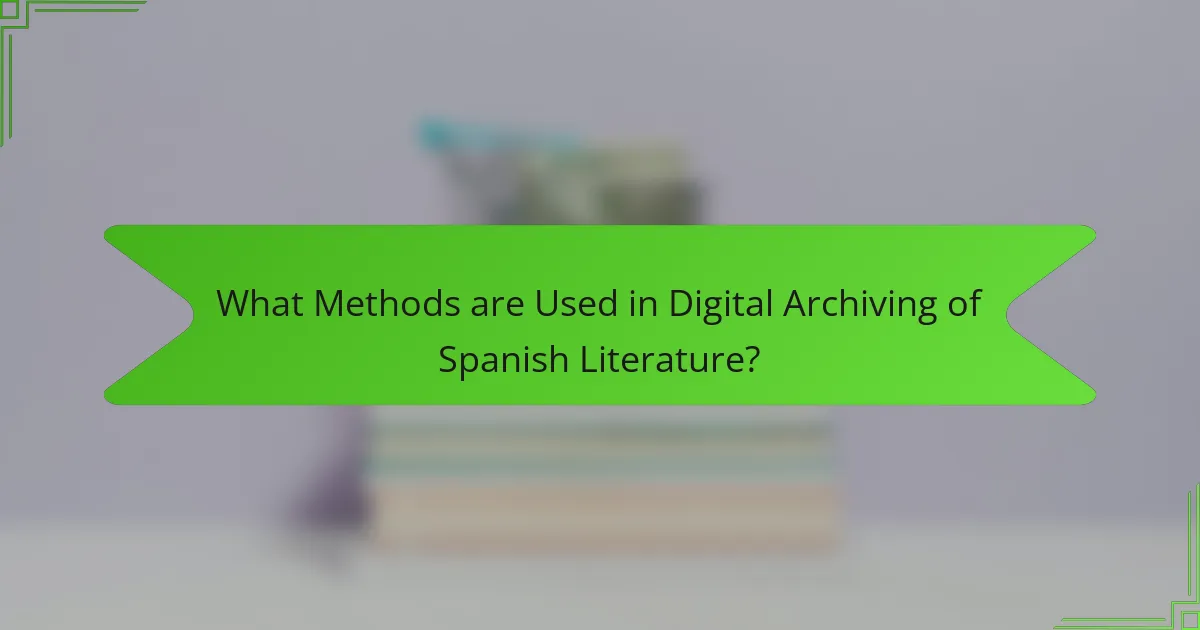
What Methods are Used in Digital Archiving of Spanish Literature?
Digital archiving of Spanish literature employs methods like digitization, metadata creation, and preservation techniques. These methods enhance accessibility and ensure the longevity of literary works.
Digitization converts physical texts into digital formats, allowing for easier distribution and access. Metadata creation involves tagging documents with relevant information, improving searchability. Preservation techniques focus on maintaining the integrity of digital files over time, using formats that resist obsolescence.
Additionally, collaborative platforms enable scholars to contribute to and share resources, fostering a community around Spanish literature. These methods collectively enhance the importance and accessibility of Spanish literary heritage.
Which Technologies Facilitate Digital Archiving?
Digital archiving of Spanish literature is facilitated by technologies such as cloud storage, digitization tools, and metadata standards. These technologies enhance accessibility, preservation, and organization of literary works. Cloud storage allows for scalable data management, while digitization tools convert physical texts into digital formats. Metadata standards ensure consistent cataloging, improving searchability and user experience.
How are Metadata Standards Applied in Spanish Literary Archives?
Metadata standards are crucial in Spanish literary archives for organizing and preserving literature effectively. They ensure consistent description, facilitate access, and enhance discoverability of literary works. Common standards include Dublin Core and MARC, which provide frameworks for cataloging authors, titles, and publication dates. These standards support interoperability among various archives, allowing researchers to locate resources across different platforms efficiently. By applying these standards, archives can maintain the integrity of literary collections while promoting greater accessibility for scholars and the public.
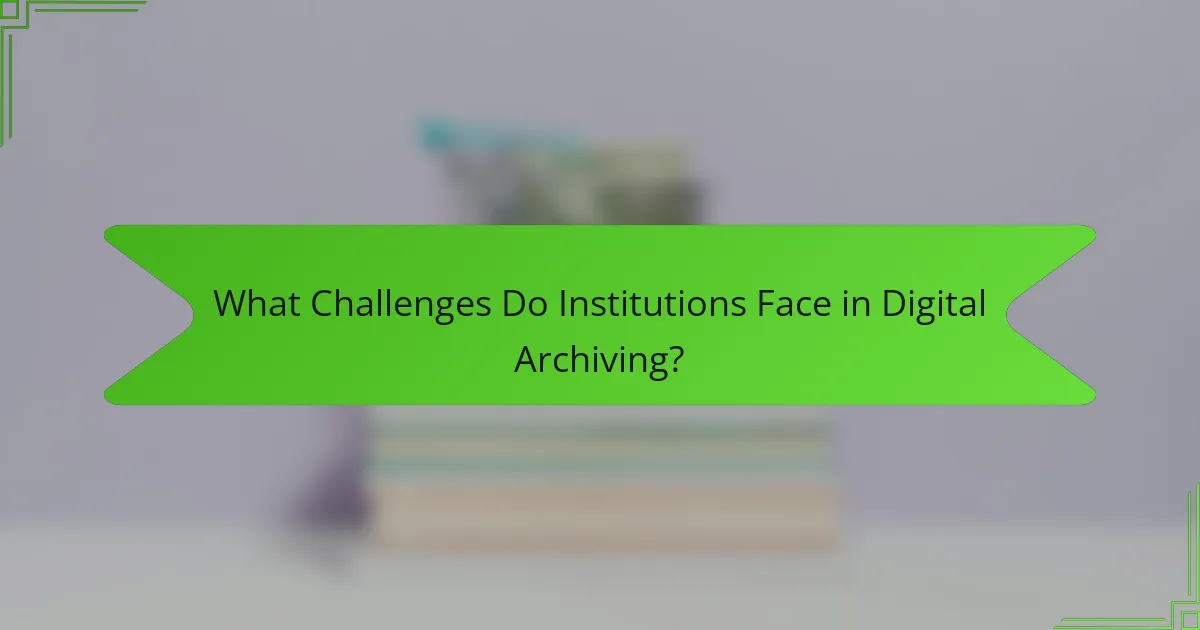
What Challenges Do Institutions Face in Digital Archiving?
Institutions face several challenges in digital archiving of Spanish literature, including technological limitations, funding constraints, and copyright issues. These obstacles hinder the preservation and accessibility of important literary works. Additionally, there is a lack of standardized methods for digitization, which can lead to inconsistencies in quality and metadata. Ensuring long-term digital sustainability is another significant challenge, as formats and storage solutions evolve rapidly. Furthermore, training personnel in digital archiving techniques is often overlooked, resulting in skill gaps that impede effective archiving efforts.
How Do Copyright Issues Impact Digital Archiving Efforts?
Copyright issues significantly hinder digital archiving efforts for Spanish literature. These legal constraints restrict access to texts, complicate preservation, and limit the ability to share resources. As a result, archivists must navigate complex copyright laws, often leading to incomplete collections. The importance of addressing these challenges is crucial for enhancing accessibility and ensuring the longevity of literary heritage.
What are the Technical Limitations of Current Archiving Methods?
Current archiving methods face several technical limitations that hinder the preservation of Spanish literature. These include inadequate digital storage formats, challenges in metadata standardization, and limited accessibility for diverse audiences.
Inadequate storage formats can lead to data loss or corruption over time. Many existing formats do not support the rich textual features found in Spanish literature, such as special characters or complex formatting.
Metadata standardization is crucial for effective archiving. However, the lack of universally accepted standards complicates the organization and retrieval of archived works, making it difficult for researchers and readers to access content seamlessly.
Accessibility remains a significant barrier. Many digital archives are not user-friendly, limiting access for individuals with disabilities or those unfamiliar with technology. Ensuring that Spanish literature is accessible to all audiences is essential for fostering engagement and appreciation.
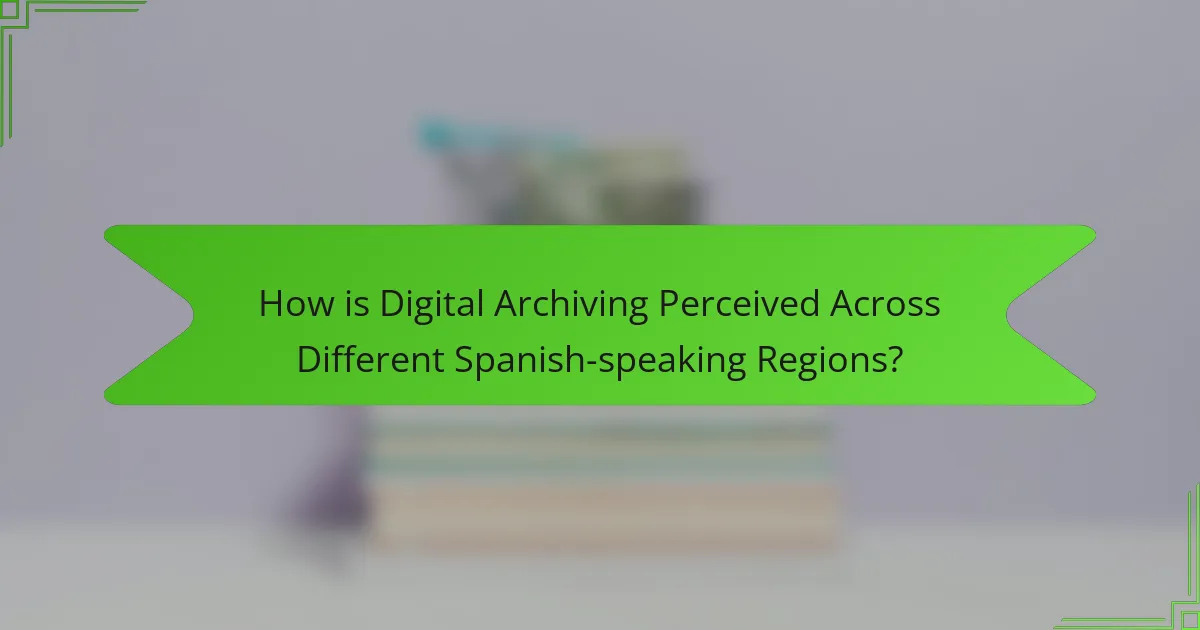
How is Digital Archiving Perceived Across Different Spanish-speaking Regions?
Digital archiving of Spanish literature is perceived positively across various Spanish-speaking regions, emphasizing its importance for cultural preservation and accessibility. In Spain, there is a strong focus on digitizing historical texts, which enhances public access to literary heritage. Latin American countries prioritize the archiving of contemporary works, facilitating the promotion of local authors.
The methods of digital archiving vary, with Spain utilizing advanced technologies for preservation, while some Latin American regions face challenges related to infrastructure. Accessibility remains a crucial concern, as disparities exist in internet connectivity and digital literacy among different regions.
As a result, initiatives aimed at improving digital archiving practices are gaining momentum, fostering collaboration between governments, educational institutions, and cultural organizations. This collective effort aims to ensure that Spanish literature remains accessible to future generations.
What Role Do Local Institutions Play in Archiving Literature?
Local institutions play a crucial role in archiving Spanish literature by preserving cultural heritage and enhancing accessibility. They implement digital archiving methods that ensure the longevity of literary works. These institutions often collaborate with libraries, universities, and cultural organizations to create comprehensive databases. As a result, they facilitate research and public engagement with Spanish literature, making it more accessible to diverse audiences. Their efforts contribute to the preservation of unique texts that might otherwise be lost, highlighting the importance of local initiatives in the broader context of literary archiving.
How Do User Engagement and Behavior Vary by Region?
User engagement and behavior in digital archiving of Spanish literature vary significantly by region due to cultural, technological, and educational factors. For example, regions with a strong emphasis on education and cultural heritage, such as Spain and Latin America, show higher engagement levels. In contrast, areas with limited access to technology may exhibit lower interaction rates. Accessibility of digital archives also influences user behavior; regions with robust internet infrastructure facilitate greater participation.
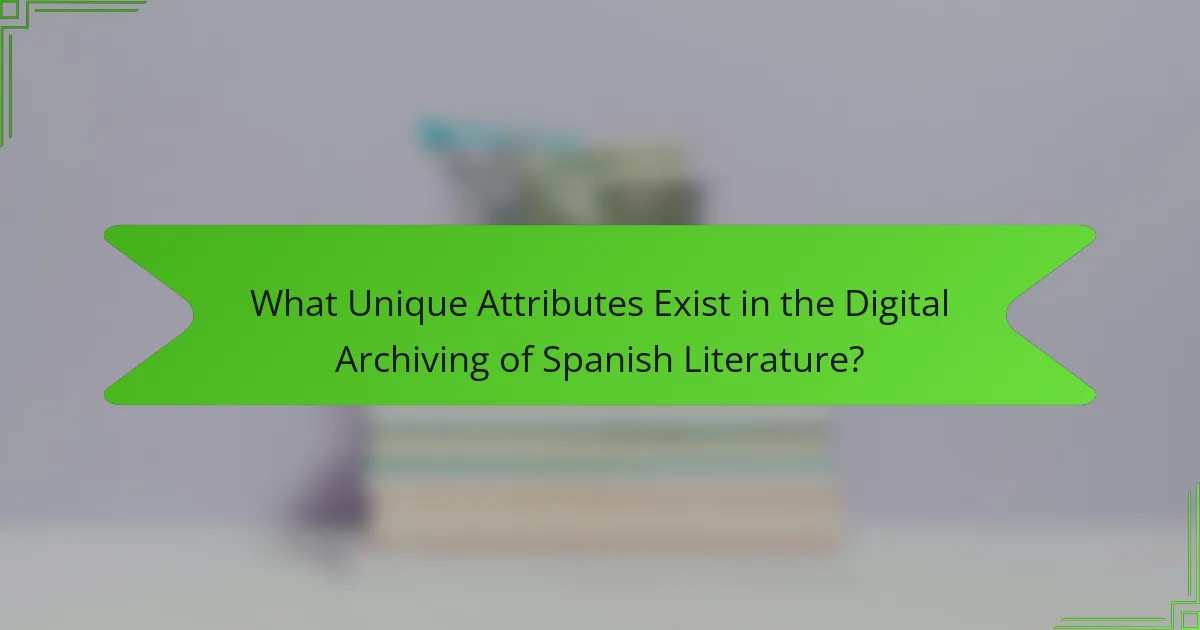
What Unique Attributes Exist in the Digital Archiving of Spanish Literature?
The digital archiving of Spanish literature possesses unique attributes that enhance preservation and access. These attributes include the integration of multimedia elements, such as audio and video, which enrich the reader’s experience. Additionally, the use of advanced metadata standards allows for improved searchability and categorization, making it easier for researchers to locate specific works. Collaborative platforms enable contributions from various stakeholders, fostering a community-driven approach to archiving. Furthermore, the incorporation of interactive features, like annotations and digital exhibits, offers deeper engagement with texts. Lastly, the focus on open access principles ensures that these literary treasures are available to a global audience, promoting cultural exchange and education.
Which Notable Projects Showcase Innovative Archiving Techniques?
Digital archiving projects that showcase innovative techniques include the Biblioteca Digital Hispánica, Proyecto Gutenberg, and the Digital Library of the Spanish Language. These initiatives employ methods like OCR technology, metadata enrichment, and user-friendly interfaces to enhance accessibility and preservation.
The Biblioteca Digital Hispánica offers digitized access to rare Spanish texts, promoting cultural heritage. Proyecto Gutenberg focuses on providing free eBooks, utilizing a collaborative approach for text digitization. The Digital Library of the Spanish Language integrates advanced search functionalities, making literature more accessible to global audiences.
How Do Cultural Differences Influence Archiving Practices?
Cultural differences significantly shape archiving practices in the digital preservation of Spanish literature. Variations in cultural values, historical contexts, and technological access influence how literary works are archived and made accessible. For example, some cultures prioritize the preservation of oral traditions, while others focus on written texts. Additionally, approaches to digital archiving can differ based on local regulations and funding availability, affecting the methods used and the importance placed on accessibility. This diversity highlights the need for tailored archiving strategies that respect cultural nuances while promoting the preservation of Spanish literary heritage.
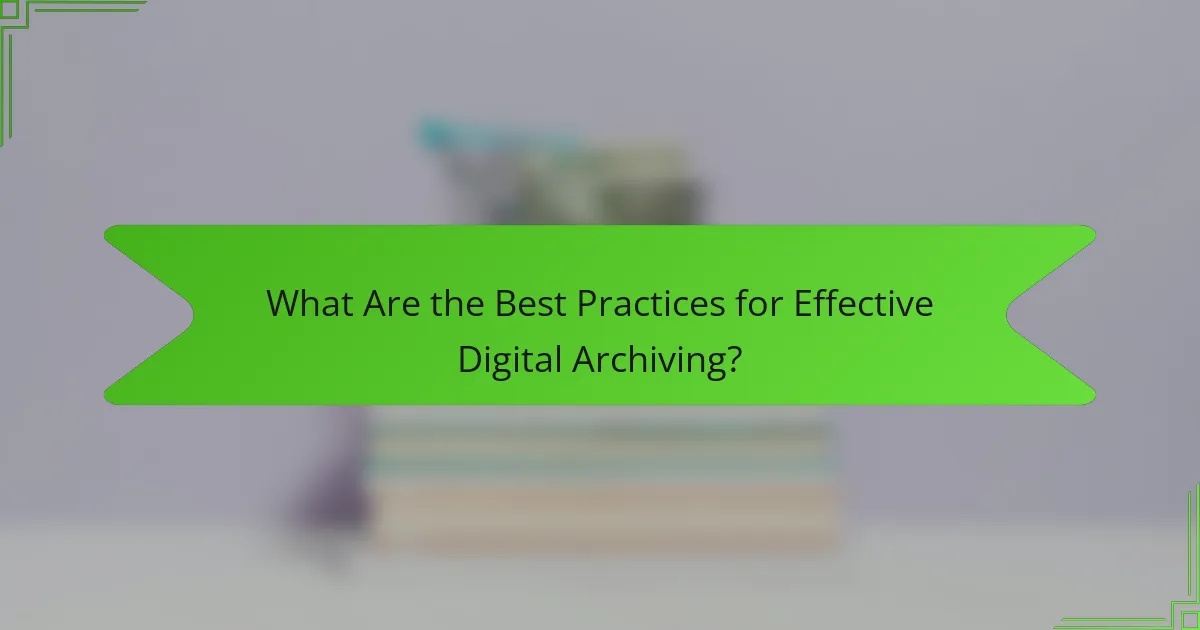
What Are the Best Practices for Effective Digital Archiving?
Effective digital archiving of Spanish literature involves systematic organization, metadata application, and user-friendly access. Prioritize consistent file formats, such as PDF or EPUB, to ensure long-term readability. Implement robust metadata standards to enhance discoverability. Utilize cloud storage solutions for scalability and security. Engage with community platforms to promote access and collaboration, fostering a shared resource for researchers and enthusiasts.
How Can Institutions Optimize Their Digital Archiving Strategies?
Institutions can optimize their digital archiving strategies by implementing comprehensive metadata standards and ensuring user-friendly access. Prioritizing preservation techniques enhances the longevity of Spanish literature. Integrating advanced search functionalities improves accessibility for researchers and readers. Collaborating with technology partners can facilitate better storage solutions and innovative archiving methods.
What Common Mistakes Should Be Avoided in Digital Archiving?
To avoid common mistakes in digital archiving of Spanish literature, focus on proper metadata, consistent file formats, and secure storage. Neglecting these aspects can lead to accessibility issues and loss of valuable content.
First, ensure accurate and comprehensive metadata for each archived item. This facilitates searchability and context. Second, choose standardized file formats to prevent future compatibility problems. Lastly, prioritize secure storage solutions to protect against data loss or corruption.
